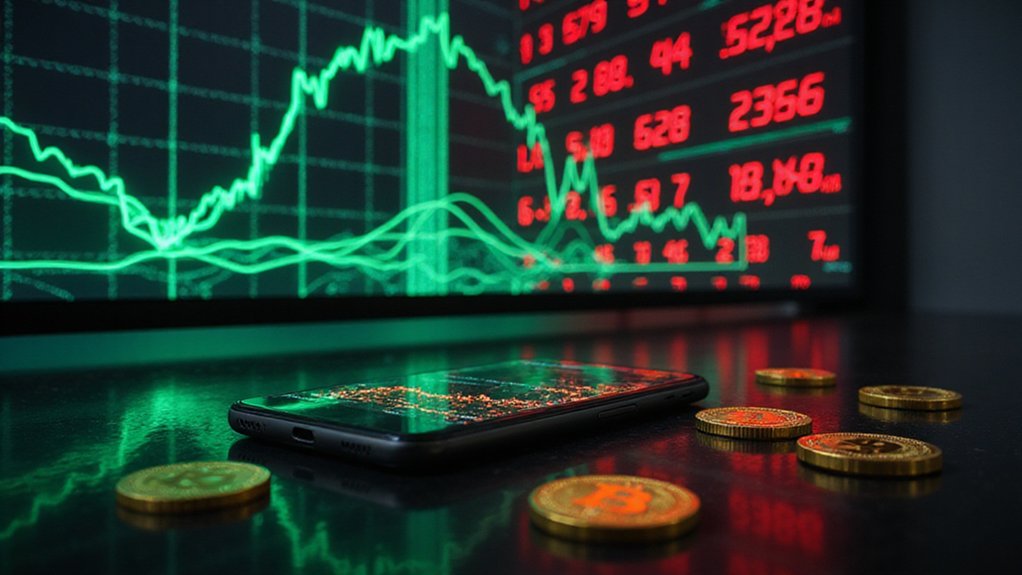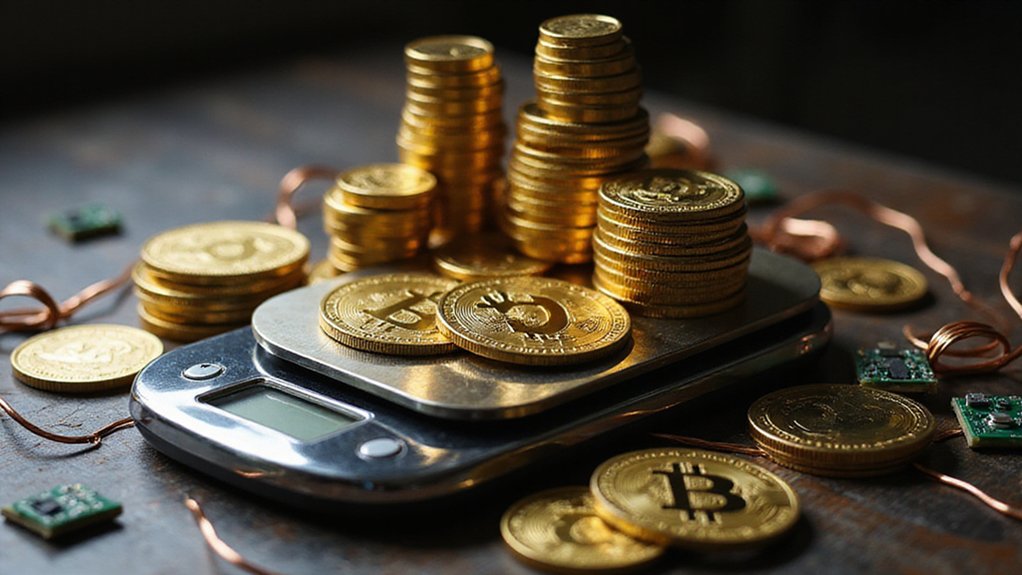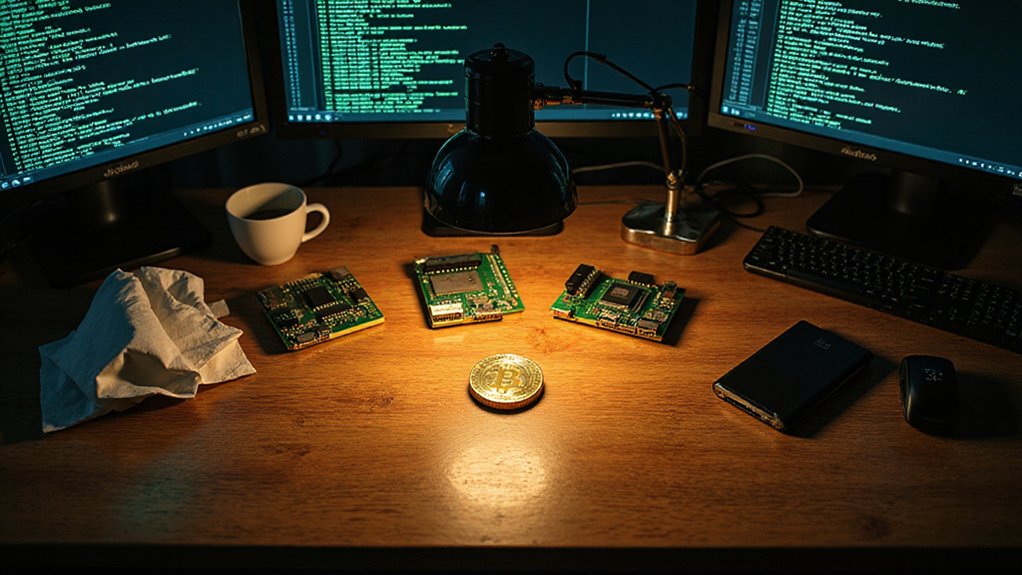Cryptocurrency volatility stems from a perfect storm of structural deficiencies that would make traditional asset managers reach for antacids. Limited liquidity allows modest trading volumes to trigger dramatic price swings, while regulatory uncertainty creates real-time risk reassessments whenever major economies issue pronouncements. Perhaps most remarkably, noise accounts for approximately 40% of price variance—dwarfing traditional assets where fundamentals typically dominate—as retail investors chase social media sentiment with the fervor of medieval crusaders pursuing digital gold.

Why does a single tweet from an eccentric billionaire send Bitcoin tumbling by double digits while the S&P 500 barely registers a blip when the Federal Reserve adjusts interest rates? The answer lies in cryptocurrency’s unique volatility profile—a fascinating study in market inefficiency that would make traditional finance professors simultaneously cringe and marvel.
Volatility, defined as the extent of price fluctuations over time, reaches extraordinary heights in crypto markets.
While traditional assets exhibit predictable patterns of risk and return, cryptocurrencies operate in a domain where 20% daily swings barely raise eyebrows among seasoned traders.
This heightened volatility stems from fundamental structural differences that separate crypto from conventional financial instruments.
Cryptocurrency markets operate on fundamentally different principles than traditional finance, creating inherent instability that defies conventional investment wisdom.
Liquidity—or rather, the conspicuous lack thereof—creates an environment where relatively modest trading volumes can trigger dramatic price movements.
Unlike established markets with deep order books and institutional market makers, crypto exchanges often resemble shallow pools where a single whale’s movement can create tsunamis.
This illiquidity makes markets particularly susceptible to manipulation and global news events, creating feedback loops that amplify volatility exponentially.
Regulatory uncertainty adds another layer of complexity.
The absence of consistent global frameworks means that regulatory announcements from major economies can instantly reshape market sentiment.
China’s 2021 cryptocurrency ban demonstrated this phenomenon spectacularly, sending prices plummeting as investors scrambled to reassess risk profiles in real-time.
Perhaps most intriguingly, research indicates that “noise”—essentially random, non-fundamental price movements—accounts for approximately 40% of cryptocurrency price variance.
This figure dwarfs noise components in traditional assets, where fundamental analysis and rational pricing models maintain greater influence.
The prevalence of retail investors, often driven by social media sentiment rather than rigorous financial analysis, creates an environment where speculation frequently overwhelms fundamentals.
Market sentiment, amplified by social media platforms, transforms everyday investors into day traders armed with smartphones and half-digested technical analysis.
Fear and greed—those timeless market emotions—manifest with particular intensity in crypto spaces, where communities can collectively decide a digital asset’s fate based on memes, celebrity endorsements, or perceived technological breakthroughs.
Bitcoin’s scarcity becomes particularly pronounced as the cryptocurrency approaches its hard cap of 21 million coins, creating artificial pressure that intensifies price competition among investors.
This volatile landscape reflects crypto’s adolescent stage: markets lacking mature institutional infrastructure while simultaneously attracting unprecedented retail participation, creating a perfect storm of unpredictability. Contributing to this dynamic is the growing institutional adoption which has introduced new layers of complexity to pricing mechanisms, as traditional financial entities bring different risk management approaches and trading strategies to the market. Despite this extreme volatility, Bitcoin has maintained 3-4 times the volatility of traditional equity indices, yet remains less volatile than some individual securities within the S&P 500.
Frequently Asked Questions
How Can I Predict When Crypto Prices Will Crash or Surge?
Predicting crypto crashes requires combining technical indicators (RSI heatmaps, moving average crossovers), quantitative models (LSTM networks, variance decomposition), and sentiment analysis.
Traders monitor volume spikes, whale activity, and social media trends while watching for clustering signals—RSI above 70 paired with volume surges often precedes corrections.
Deep learning models trained on historical data offer forecasting capabilities, though accuracy varies greatly depending on training periods and market conditions.
Which Cryptocurrencies Are Least Volatile for Conservative Investors?
Conservative crypto investors gravitate toward stablecoins like USDT and USDC, which maintain dollar pegs through various mechanisms (some more transparent than others).
Bitcoin, despite its dramatic headlines, exhibits relatively lower volatility compared to altcoins due to superior liquidity and institutional adoption.
Market capitalization remains the primary stability indicator—larger coins face fewer dramatic swings since moving billion-dollar assets requires considerably more coordinated effort than pumping obscure tokens.
Should I Buy More Crypto During a Market Dip or Wait?
The eternal crypto conundrum: catching falling knives or practicing patience.
Dollar-cost averaging during dips offers mathematical elegance—accumulating assets at progressively lower prices while volatility does its theatrical dance.
However, waiting for trend confirmation reduces downside exposure, particularly given Bitcoin’s recent $109K-to-sub-$90K gymnastics.
The prudent approach involves scaling positions gradually rather than deploying capital wholesale, monitoring institutional flows and on-chain metrics to distinguish genuine bottoms from temporary pauses in broader capitulation.
How Do Crypto Taxes Work When Prices Fluctuate Constantly?
Crypto taxes operate on realized gains, not fluctuating market values—fortunately, the IRS doesn’t demand payment on paper profits that vanish overnight.
Only actual transactions (selling, exchanging, spending) trigger taxable events, with gains calculated from original purchase price to disposal price.
Short-term holdings face ordinary income rates up to 37%, while long-term positions enjoy preferential capital gains treatment.
Meticulous record-keeping becomes essential when tracking cost basis across volatile price swings.
What’s the Best Time of Day to Trade Cryptocurrency?
Ideal crypto trading windows cluster around major market overlaps: 2:30-4:30 PM UTC when London and New York sessions converge, delivering peak liquidity and volatility.
Tuesday through Thursday typically offer superior conditions, while early morning (6:00-9:00 AM IST) captures Asian-European overlap.
Given crypto’s perpetual operation—unlike traditional markets with their quaint closing bells—these patterns merely suggest probability, not certainty.
Savvy traders recognize that market-moving news respects no timezone, rendering “ideal” timing partly illusory.









